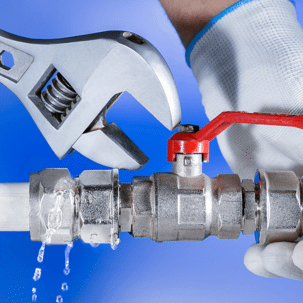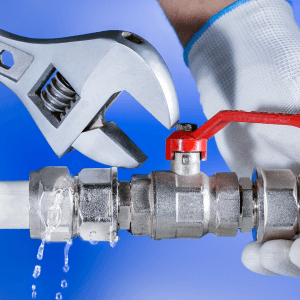Water’s soothing presence in our lives, be it through a calm rain shower or a relaxing bath, often makes us forget its more challenging side. But as soon as that unwanted drip or unexplained puddle appears, the serenity shatters. If you’re wondering how to fix a plumbing leak, you’re in the right place. But remember, while DIY fixes can offer temporary relief, there’s nothing quite like a professional touch for a lasting peace of mind.
Spot the Culprit
Before you start fixing a leak, it’s super important to find out exactly where it’s coming from. Even though it might seem easy, small plumbing leaks can be hard to locate. Water often moves away from the real leak before you see it as a puddle or wet spot. If you’re having trouble figuring out where the leak is, don’t worry. Skilled plumbers have special tools and know a lot about this stuff. They can quickly find even the trickiest leaks, making sure no damage goes unnoticed. This is why professional leak detection services are really helpful.
Seal Minor Leaks
When facing minor leaks, the urge to patch things up quickly is understandable. Here are a couple of DIY methods you can consider:
-
Plumber’s Tape:
Often referred to as Teflon tape or thread seal tape, plumber’s tape is a thin white adhesive specifically crafted to ensure watertight sealing of threaded pipe connections. When opting for this solution, the first step involves cleaning the threaded area. It’s essential to rid this space of any residual sealant or debris to ensure the tape adheres effectively. Once cleaned, start at the end of the threads and begin wrapping the tape. It’s crucial to apply the tape snugly, wrapping it several times around. As you proceed, make sure to overlap each layer slightly to guarantee full coverage. After you’ve ensured a tight wrap, press down on the tape’s end to anchor it, preventing it from peeling off. With the tape securely in place, you can then proceed to reconnect the threaded parts, ensuring a watertight seal.
-
Epoxy Compounds:
Epoxy can be effective for stopping minor drips, although it requires temporarily halting the water flow for proper setting. If you decide to use epoxy, preparation is key. Begin by shutting off the water supply to the leak’s location. This step is crucial as it guarantees a dry work area, allowing the epoxy to set undisturbed. Once the water is off, your next step is to thoroughly clean the affected zone. Ensure it’s free from dirt, grease, or any rust to ensure optimal adherence of the epoxy. With the area prepped, follow the manufacturer’s guidelines to mix the epoxy correctly. When it’s ready for application, generously coat the leak, extending the application slightly beyond the leak site to ensure a comprehensive seal. After applying, patience is key. Give the epoxy adequate time to set—typically several hours, based on the manufacturer’s recommendation—before you think of turning the water back on.
Patch It Up
Dealing with a hole or crack? While this might initially sound alarming, there are ways to address the situation:
-
Rubber and Clamps:
A makeshift remedy involves using a rubber piece secured with clamps over the hole. It’s a temporary solution that could buy you some time until professional assistance arrives.
-
Pipe Repair Kits:
These kits can be quite handy and represent an improvement over the rubber fix. However, they may not always provide a lasting resolution, particularly if there are underlying issues causing the pipes to crack or corrode.
Address Broken Pipes
A broken pipe can quickly escalate into a homeowner’s nightmare:
Your first priority should be to turn off the water supply to prevent further damage. If you’re confident in your abilities and have the necessary tools, you can attempt to replace the damaged section.
However, incorrect installations can lead to more extensive problems later on. In such scenarios, it’s often wiser to rely on seasoned professionals. They can not only replace the damaged portion but also identify and rectify the root causes, ensuring that you’re safeguarded against recurring issues.
Consider Professional Plumbing Services
Enlisting the expertise of a professional plumber, especially during complex situations or persistent issues, is often the wisest decision a homeowner can make. While many might be tempted by the immediate cost savings of a DIY approach, plumbing presents challenges where the risk of error can have far-reaching consequences. Professionals, like the seasoned team at R.S. Andrews, possess not only the necessary tools but also a depth of experience to ensure that plumbing issues are diagnosed accurately and rectified efficiently.
Opting for professional intervention goes beyond merely fixing a problem; it’s about securing peace of mind. A skilled plumber can identify the root causes behind visible issues, providing comprehensive solutions that prevent future recurrence. Additionally, their insights on maintenance and preventative measures can be invaluable for homeowners looking to preserve the integrity of their plumbing system. In the intricate realm of pipes and leaks, the nuanced expertise of a plumbing professional remains an invaluable asset.
Frequently Asked Questions
Are DIY repairs cost-effective in the long run?
Initially, DIY methods might seem like a wallet-friendly choice. They offer a relatively quick solution without the immediate costs associated with professional services. However, the DIY approach may not always effectively diagnose or remedy the root of the problem. Misdiagnosis, inappropriate tools, or even slight mishandling can sometimes exacerbate the issue.
I’ve sealed a leak, but it’s back again. Why?
Experiencing a leak that you’ve previously addressed can be frustrating and puzzling. Several reasons might be at play here. For starters, the initial repair might have been a superficial solution, not addressing the deeper issue. Another possibility is that environmental factors or regular wear and tear have reopened or created a new leak nearby.
How can I be sure my plumbing is in good shape?
The assurance of a plumbing system’s integrity goes beyond just addressing visible leaks or blockages. To truly ensure your plumbing is in optimal condition, a proactive approach is necessary. Regular inspections, maintenance routines, and timely interventions are key.
What are common signs of a hidden plumbing leak?
Hidden plumbing leaks may manifest in various ways: unexpected rises in water bills, damp spots or mold growth on walls, ceilings, or floors, a persistent musty smell, or even hearing the sound of running water when no taps are on.
Can small plumbing leaks lead to bigger issues?
Absolutely. Even a minor leak can escalate into larger problems if not addressed timely. Over time, water damage can compromise the structural integrity of a building, promote mold and mildew growth, and lead to expensive repairs.
When in doubt or when a leak seems too challenging, remember, R.S. Andrews is just a call away, bringing expert solutions to all your plumbing challenges!
Tackling a leak might seem empowering, but without the right expertise, it’s easy to miss underlying problems or apply fixes that might not last. It’s always a good idea to consult or hire professionals for a more comprehensive and lasting solution.


